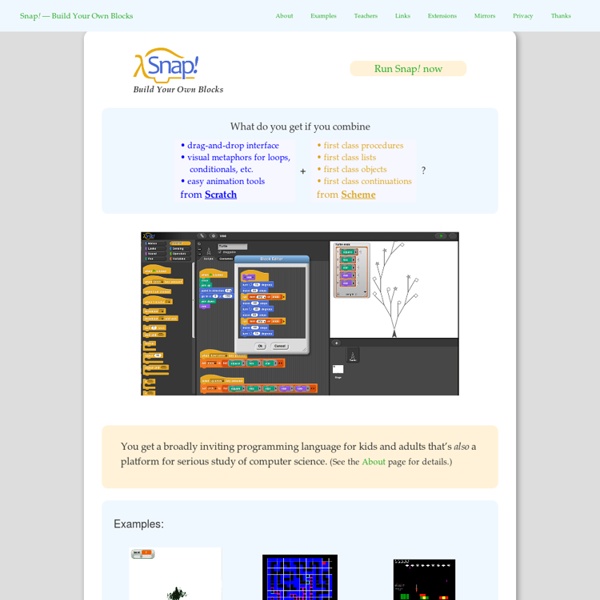



Learn Play, Design & Code Retro Arcade Games Grades 2+ | Blocks CS First Unplugged Grades 2-8 | Blocks, Unplugged, Scratch Discover Python with Silent Teacher Coding with Chromebooks The Hour of Code is upon us which reminds me of a question I am asked more often than I would believe, “Do my students really need to learn to code?” I think what is really behind this question is, “If I’m not a programmer, is this really useful to me?” To which I respond a resounding “YES!” Here is why I believe it’s so important.
Programming With Blocks Syntax is a royal pain in the neck for beginning programmers. For a lot of kids learning computing or programming syntax is the single largest hurtle. It’s hard to teach both a new (programming) language and a new way of thinking and problem solving at the same time. This tends to be a big stumbling block for teaching a lot of basic computing concepts. For years there have been tools developed that remove syntax from the equation.
Root - A robot to teach coding by Scansorial Kickstarter Collections Projects We Love 5 of The Best iPad Apps for Teaching Kids Coding Through Games Coding is believed to be the 21st century literacy par excellence. Codes make up the totality of our digital world. They are a universal language that every computer speak. Teaching kids coding will not only enable them to better understand the digital world surrounding them but, more importantly, will equip them with skills integral to their overall learning. Coding is all about creativity, imagination, problem solving and strategic thinking. There is a wide variety of ways to make learning programming and coding a fun an enjoyable task for kids. 4 Great Web Tools for Creating Educational Games June 15, 2016 Below are five of our favourite platforms that you can use with your students to create a wide variety of learning games. No coding skills are required. Designing learning games is a great way to develop students analytic thinking and foster self-expression. It is also an effective way to introduce students to basic coding and programming concepts and help them cultivate 21st century learning skills.
A New Website from Google to Help Students Learn Coding April 22, 2016 Google has recently launched a new interesting website called Computer Science Education to help students learn coding and computer science. Google Computer Science Education provides a collection of powerful tools, resources and programs to engage students in learning about the wonders of computer science. It also provides them with a number of scholarships, internships, residences and several other resources to help them develop their professional and technical skills. Game Maven from Crunchzilla <h2>Game Maven from Crunchzilla is an interactive tutorial that lets anyone experiment with coding and write a few games.<p> Game Maven from Crunchzilla uses Javascript. Please enable Javascript if you want to play with Game Maven. Otherwise, Game Maven will not be able to play with you. </p><p></h2>
Code Maven from Crunchzilla <h2>Code Maven gets teens excited about programming. It is an interactive tutorial where anyone can experiment with learning to code. <p> Code Maven from Crunchzilla uses Javascript. Please enable Javascript if you want to play with Code Maven. Code Monster from Crunchzilla <h2>Code Monster gets kids excited about programming. It is a combination of a game and tutorial where kids experiment with learning to code. <p> Code Monster use Javascript. Please enable Javascript if you want the play with the Code Monster. Hour of Code Suggestions by Grade Level Here are ideas of apps and websites that teachers in my PLN used successfully in the past during Hour of Code: Kindergarten Start kindergartners with problem solving. If they love Legos, they’ll love coding BotLogic–great for Kindergarten and youngersCode–learn to code, for studentsDaisy the Dinosaur—intro to programming via iPadHow to train your robot–a lesson plan from Dr.